
Original Link: https://www.anandtech.com/show/2062
ASRock Core 2 Duo: AGP/PCI Express Graphics Performance, Part Tres
by Gary Key on August 15, 2006 6:30 AM EST- Posted in
- Motherboards
AGP and PCI Express Performance
In our first article we compared the performance of DDR versus DDR2 on the ASRock 775Dual-VSTA motherboard and found there was very little difference between DDR-400 and DDR2-533 on this platform. In our second article we compared the performance of DDR against DDR2 on several different platforms that included the VIA PT880 Pro, Intel 865, Intel 945P, Intel P965, and Intel 975X chipsets. Our results showed that while there were differences in memory performance between each chipset and speed setting, it mattered little in the overall performance of our system. This was mainly due to our selection of mid-range components that likely would be used when upgrading to our motherboard and processor choice.
Our article today will look at the performance differences between AGP and PCI Express graphics cards on the ASRock 775Dual-VSTA motherboard with Intel's E6300 Core 2 Duo. We will state up front that our article today is not a video card review. Instead we are verifying if AGP performance on our test motherboards is acceptable when comparing it to PCI Express performance on the VIA PT880 Pro chipset used on our ASRock test platform. Our tests today will be utilizing the EVGA 7600GS and 6800 Ultra series of video cards in both PCI Express and AGP configurations. Both series of cards offer decent performance that is well suited for 17" or 19" LCD monitors running at resolutions up to 1280x1024. While both cards will struggle with current games such as Oblivion -- a game that will bring most systems to their knees -- they still offer a fair amount of performance for games released the past couple of years and can certainly handle any normal desktop application work with ease.
The typical user who will purchase a motherboard of this type or the AGP only ASRock 775i65G are primarily concerned about extending their current component investments while upgrading to the latest Core 2 Duo processor series from Intel. These component investments usually include AGP graphics, DDR memory, along their current power supply, storage, and optical drives. Based upon this profile our tests will utilize DDR memory only and video cards that represent typical performance in the mid to lower range of graphics capability at this time. Additional graphics performance results when utilizing DDR2 memory combined with other chipsets can be found in our last article.
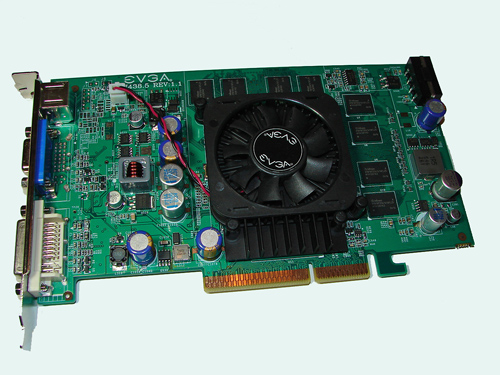
The ASRock 775Dual-VSTA motherboard offers AGP 8X/4X capability along with PCI Express X4 graphics performance. However, our PCI Express video cards will theoretically be at a disadvantage due to the bandwidth differences between X4 mode and our AGP 8X capability. We would like to see if the difference in bandwidth affects performance, though realistically we're only measuring the performance of one specific design as opposed to AGP versus PCI Express; we cannot say for certain that the PCI Express implementation of the PT880 chipset is fully competitive with other PCI Express implementations. Still, it is possible that the X4 slot will saturate the PCI-E bus, which can certainly occur in some cases based upon graphics settings and applications.
AGP 8X has up to 2.1GB/s of shared bandwidth. The typical GPU can make use of nearly all the bandwidth, but the upstream bandwidth isn't as important. Various requirements for upstream transfers end up limiting the maximum upstream throughput to around 266 MB/s, and switching back and fortch between reads and writes can incur a further performance penalty. Typical desktop applications tend to utilize the downstream bandwidth (read from system) the greatest amount of time while upstream bandwidth (write to system) is seldom used and is rarely an issue. The design of AGP took this into account, which is why the realizeable upstream bandwidth is so much lower than the downstream bandwidth.
PCI Express X16 operation has 8GB/s of theoretical bandwidth that is segregated for upstream and downstream paths due to its serial bus design. Technically, the PCI-E bus transmits at 2.5 Gbps on each link, so 2.5 Gbps x 16 = 40 Gbps. Converting to bytes that gives 5 GB/s, but like most serial buses there is a 20% transaction overhead that reduces the useable bandwidth to about 4 GB/s. Thus we arrive at the result of 4 GB/s of read and write speed for each direction at maximum bus capacity. Once again, the majority of application usage is spent on the read side with the write side capacity being wasted for the most part in current PCI Express graphics systems, but there is the potential for it to become more important in the future, and SLI/CrossFire implementations using the PCI-E bus to transmit data certainly benefit.
Since our test board is operating in X4 mode we have one fourth of the bandwidth available which equates to about 1000MB/s upstream and 1000MB/s downstream. This is slower than AGP 8X since the available read bandwidth is limited and can be saturated by certain applications, making AGP 8X potentially more effective. PCI Express X4 offers about half the available read bandwidth of AGP 8X, and the write performance advantage of PCI-E goes largely unused in most applications.
Let's see if this theory holds true in our test results -- again, recognizing that we are only comparing performance on one specific chipset.
System Configuration
Our memory benchmark system uses the following components:
| Performance Test Configuration | |
| Processor: | Intel Core 2 Duo E6300 (Dual core 1.86GHz 2MB Unified Cache) |
| RAM: | 2 x 512MB Patriot DDR-400 (1GB Kit - 2x512 MB) |
| Hard Drive: | Seagate 320GB 7200.10 (16MB Buffer) |
| System Platform Drivers: | VIA 5.09a Intel 8.0.1.1002 |
| Video Cards: | 1 x EVGA 7600GS PCI-E - PCI-E Tests 1 x EVGA 7600GS AGP - AGP Tests 1 x EVGA 6800 Ultra PCI-E - PCI-E Tests 1 x EVGA 6800 Ultra AGP - AGP Tests |
| Video Drivers: | NVIDIA 91.31 |
| CPU Cooling: | Stock Intel Heatsink |
| Power Supply: | OCZ PowerStream 520W |
| Motherboards: | ASRock 775Dual-VSTA (VIA PT880Pro) ASRock 775i865G (Intel 865G) |
| Operating System: | Windows XP Professional SP2 |
| BIOS: | AMI 1.50 - ASRock 775Dual-VSTA AMI 2.50 - ASRock 775i65G |
Our test boards represent a blend of performance and pricing requirements for a value-oriented E6300 Core 2 Duo system. The choice of components is designed to provide apples to apples comparison between the PCI Express and AGP capability on our ASRock 775Dual-VSTA platform. We chose the ASRock 775i865G motherboard to provide a comparable AGP system for testing that provided DDR memory capability. We are also only reporting results with DDR memory as the typical user upgrading to either board would probably have both an AGP video card and DDR memory available for use.
Our EVGA 7600GS PCI Express or AGP video card choice represents a very good mid-range alternative and ensures you have respectable game performance at resolutions under 1280x1024 for less than $130. Our EVGA 6800 Ultra tandem represents one of the top performance cards from two years ago and should give a good indication of the performance potential of each graphics slot. Unfortunately, we were unable to procure an ATI X850XT-PE AGP card for comparison with our PCI Express version. However, we doubt there would have been any additional information gained about AGP/PCI-E performance when testing the ATI solutions.
Our feature motherboard is the ASRock 775Dual-VSTA that includes the VIA PT880 Pro Northbridge and VT8237A Southbridge which fully support Core 2 Duo with the proper VRM and BIOS support. The ASRock 775Dual-VSTA is a very unusual board considering all of the available upgrade options and is available at a low entry price of $55.
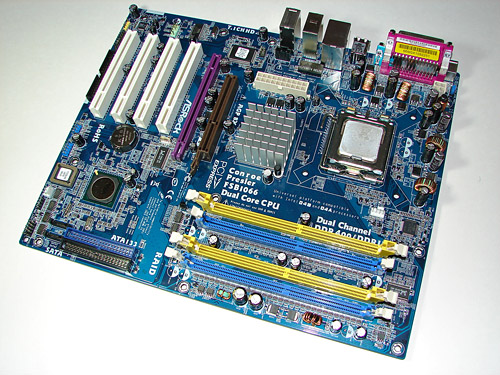 |
| Click to enlarge |
The board is laid out nicely and certainly caters to those who value IDE and PCI devices. The VT8237A only supports two SATA 1.5Gbps drives but does support four IDE devices. This board also features both AGP 8X capability, PCI-E graphics ability at X4 operation, VIA 10/100 Ethernet LAN, and Realtek ALC-888 HD 7.1 audio. The overall feature set of the VIA chipset is the same as the Biostar PT880 Pro board we reviewed a few months back.
Our other ASRock motherboard is the 775i65G based upon the Intel 865G Northbridge and ICH5 Southbridge with board updates that allow full support for the Core 2 Duo processor series. This motherboard also features on-board graphics capability but requires an external AGP card in order to support the 1066FSB requirement of the Core 2 Duo.
 |
| Click to enlarge |
The motherboard utilizes a micro ATX form factor and includes three PCI slots, one AGP 8X slot, one AMR slot, Realtek 10/100 Ethernet LAN, and C-Media 9761a 5.1 Channel audio. The layout is very good and the board is clearly designed for users who want to continue using their AGP video card and DDR memory while upgrading to a newer processor. This motherboard should retail for around US $50 and requires a revision 2 layout for Core 2 Duo compatibility.
Graphics Performance Comparison
While our previous articles concentrated on memory performance, today's article solely consists of gaming benchmarks and the synthetic 3DMark tests from Futuremark. The 3DMark series of benchmarks developed and provided by FutureMark are among the most widely used tools for benchmark reporting and comparisons. Although the benchmarks are very useful for providing consistent comparisons across a broad array of GPU and CPU configurations they are not a substitute for actual application and gaming benchmarks. In this sense we consider the 3DMark benchmarks to be purely synthetic in nature.
 |
| Click to enlarge |
The gap between PCI-E and AGP solutions is less than 2% with both video card choices. Our first tests show AGP performing slightly better than PCI-E on the VIA platform with the Intel platform performing better overall. The 6800 Ultra series outperforms the 7600GS up to 38% in 3DMark05 and 26% in 3DMark06. Let's see if these differences carry over into our game benchmarks.
We utilized Far Cry, Half Life 2 and Quake 4 in our memory test articles because they are sensitive to memory changes and potentially bus throughput issues in our comparison. We added Prey and Serious Sam 2 to our benchmark mix because they are typically very GPU dependent and scale well. We originally tested at both 1024x768 and 1280x1024 resolutions at High Quality settings without anti-aliasing or antistrophic filtering enabled. We have also added 800x600 and 1600x1200 resolutions with the same settings.
 |
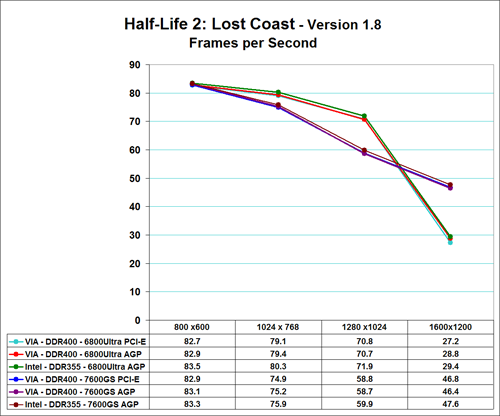 |
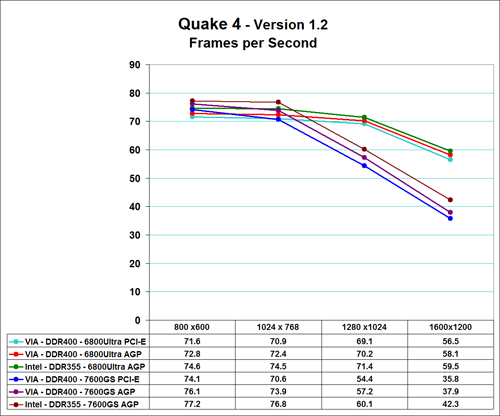 |
| Click to enlarge |
Our three memory sensitive games show a consistent pattern with the AGP capability of the ASRock 775Dual-VSTA performing up to 5% higher than the PCI-E version in our testing. Overall, the AGP slot performance is better than the PCI Express slot even in 800x600 testing where the X4 operation handicap should not make a difference. The Intel 865 chipset offers better AGP performance especially as the resolutions start to scale upward. Looking at the gaming results from our previous article, the X16 PCI-E solutions typically offer equal or better performance than the AGP offerings. Whether it's the extra bandwidth or simply a less-than-perfect PCI-E implementation on the 775Dual-VSTA we can't say without further testing. However, the bottom line is that AGP performance is better than PCI-E performance on this particular motherboard.
The 6800 Ultra is still a very competitive card when compared to the 7600GS in these particular benchmarks, although it stumbles at 1600x1200 in Half Life 2- Lost Coast. The ATI X850XT-PE would score in a similar fashion if not better than the 6800 Ultra, though of course it lacks SM3.0 support which can be useful in more recent titles. Those owners with a graphics card in this class can still get by with most of today's games. We will have Oblivion results in our final article although we highly suggest going with a different solution to play this game at decent settings
Game Performance, Continued
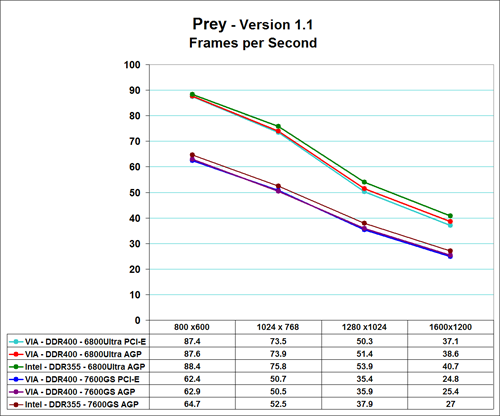 |
 |
| Click to enlarge |
In our two games that tend to be GPU limited we see the i865 AGP/DDR solution continuing the trend of offering the best graphics performance regardless of video card choice. On the VIA platform the AGP slot still provides better overall results than the PCI Express slot. The 6800 Ultra continues to offer a better gaming experience than the 7600GS at our settings mainly due to the memory speed running 300MHz higher on the 6800 Ultra. The sweet spot for gaming with the 7600 GS seems to be at 1280x1024 with the older games and at 1024x768 with the newer releases. The introduction of low antialiasing or antistrophic filtering settings at these two resolutions should still provide a decent gaming experience.
Final Words
Our results confirm that there is not a throughput performance penalty for using AGP over PCI Express on the ASRock 775Dual-VSTA. In fact, just the opposite is true in this case as our AGP graphics cards consistently scored better than their PCI-E counterparts. This is attributable to the PCI Express Graphics slot being limited to X4 operation at the upper resolutions and the slight overhead penalty incurred due to the VIA chipset design. However, the performance of the PCI Express slot is not that bad with the worst penalty being around 5% with our video cards. (Pairing the motherboard with a top end GPU results in performance that can be up to 10% slower in certain applications than competing motherboards.) If you have either an AGP or midrange PCI Express card then this board will handle both in a more than acceptable manner with today's applications.
The overall performance of the ASRock 775i65G board still surprised us, even though we already knew it was just as competitive with the other chipsets from our previous testing. It proved itself once again to be extremely stable with every benchmark or application we threw at it. If you still have a high performance AGP 8X video card and DDR memory then this board would make an incredible "budget" system with the addition of an E6300 or E6400 Core 2 Duo processor. The same holds true for the ASRock 775Dual-VSTA board which also allows you to use a current PCI Express video card at a small performance penalty and DDR2 memory which improves performance slightly over DDR-400.
If gaming is your priority then we still suggest upgrading your entire platform at this time as the top games being introduced over the next six months are just going to put additional demands on even the latest hardware. There are quite a few attractive midrange GPU offerings now available. If you happen to need a good second computer or utilize your system mainly for media encoding or general applications then either board allows you to extend your current component investment while realizing a CPU performance increase, especially when compared with older Pentium 4 or Athlon 64 systems. In the end, this might just be the most important reason to consider either board.







